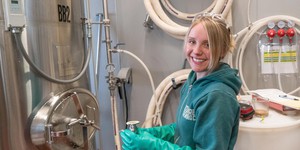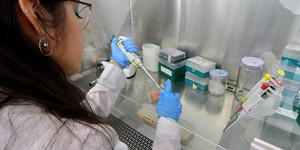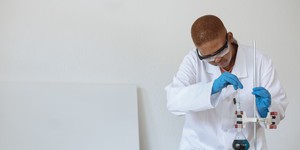Abstract
It is fun to shake up a snow globe and watch the "snow" slowly fall. You can imagine that if the snow fell down very quickly it would be disappointing. But there are times when scientists in a laboratory want this to happen. Scientists use samples that have liquid mixed with small, solid pieces (like the inside of a snow globe), and they need all of the solid pieces in a clump, separated from the liquid. Instead of waiting for the pieces to slowly fall out of the liquid, scientists speed up the process by using a piece of equipment called a centrifuge. In this science project you will build your own version of a centrifuge from a salad spinner and investigate how well it can separate pieces in a homemade snow globe (glitter mixed with water and corn syrup).Summary
Teisha Rowland, PhD, Science Buddies
- Elmer's is a registered trademark of Elmer's Products.
- Vaseline is a registered trademark of Unilever United States, Inc.
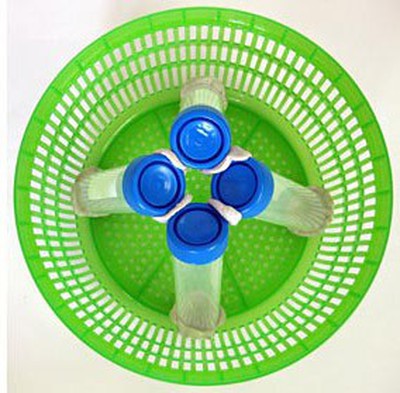
Objective
Make a centrifuge from a salad spinner and use it to investigate how well a centrifuge separates snow globe snow (glitter) from a liquid.
Introduction
It is not a surprise that snow globes, like the one shown in Figure 1, are often sold as gifts and souvenirs. When you see a snow globe, it is hard to resist shaking it and watching the "snow" inside slowly fall! Have you ever wondered what makes the snow fall? It is because the force of gravity pulls down on the snow. Just like the force of gravity pulls you down toward the ground when you hang from the monkey bars at the playground.
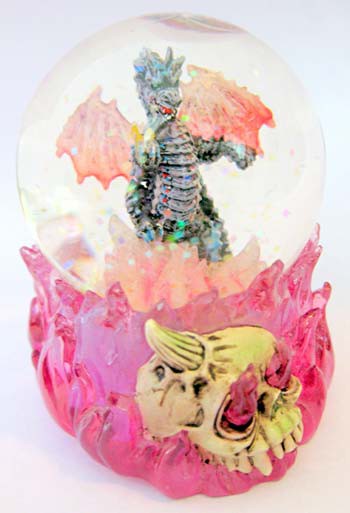 Image Credit: Teisha Rowland, Science Buddies / Science Buddies
Image Credit: Teisha Rowland, Science Buddies / Science Buddies
Figure 1. Inside a snow globe is liquid mixed with small, solid objects, or "snow." The snow in this dragon snow globe is actually glitter. Gravity is the force that causes the glitter to fall to the bottom of the globe.
How do you think you could make the snow inside the snow globe fall even faster? This might not be something you have thought about, because it would be disappointing to have a snow globe with snow that fell very quickly. The show would be over too soon! But this is something that scientists think about, and for a good reason. Sometimes scientists use samples that have a liquid mixed with very small objects, or particles, just like the inside of a snow globe. But the scientists may want to study the particles, and to do this they need to separate them from the liquid. If they used only gravity to separate the particles from the liquid it may take a long time - much longer than waiting for snow to settle in a snow globe. How do they speed this up? They use a machine called a centrifuge. Scientists use centrifuges in laboratories all the time to separate one chemical compound or biological substance from another.
How does a centrifuge help separate particles from a liquid? By spinning objects really quickly in a circle! When an object moves in a circle, the object is forced to move out, away from the center of the circle. If you do not believe it, you can try it for yourself - when you are riding in a car and it makes a quick turn, how does your body move? It moves to the outside of the turn, away from the direction of the turn and the center of the circle that the car is making!
This is similar to when samples are spun inside of a centrifuge. The samples (which usually have particles mixed with a liquid) are put inside of a tube in the centrifuge. As the tube spins, these particles hit the side of the tube because they move away from the center of the centrifuge, just as when your body is pushed to the side of a car making a turn. When the particles hit the side of the tube, they start sliding down it. If a sample is not spun very long, or not very quickly, it may end up with some particles on the side of the tube and some on the bottom of the tube. But if a sample is spun for a long time, or very quickly, more particles will slide to the bottom of the tube, and a "pellet" may form. A pellet is a relatively solid clump of particles at the bottom of the tube. The faster and longer the sample is spun, the larger the pellet may be that forms.
There are many different types of centrifuges. To see an example of one in action watch the video. Did you see how the scientists typed in the number 14,000 when setting up the centrifuge? This means that the samples inside will spin in a circle fourteen thousand times every minute — that is fast!
In this biotechnology techniques science project, you will build your own centrifuge using a salad spinner to investigate how well a centrifuge separates particles of glitter from a liquid. A salad spinner can be made into a centrifuge rather easily. Although it will not spin as fast as the one in the video, a salad spinner centrifuge still spins fast enough to do real science. In fact, such a centrifuge has even been used to analyze human blood samples! You can watch the video listed in the Bibliography by Rice University to hear about two students who made a centrifuge from a salad spinner to do just that.
Terms and Concepts
- Force
- Gravity
- Particles
- Centrifuge
- Pellet
Questions
- How does a centrifuge separate particles from a liquid?
- How is a clothes dryer like a centrifuge? How are they different?
- If you put glitter in water, what do you think would happen to the glitter?
Bibliography
Have an adult help you do further research by visiting the following websites, which give information about centrifuges:
- Kids.Net.Au. (n.d.). Centrifuge. Retrieved October 17, 2012.
- Woodford, C. (2012, September 20). Centrifuges. Explain That Stuff!. Retrieved August 20, 2012.
- The Physics Classroom. (n.d.). The Centripetal force requirement. Retrieved August 20, 2012.
- Rice University. (2010, April 30). The Sally Centrifuge. Retrieved August 20, 2012.
The recipe for the glitter mixture is based on:
- Ford, R. (2012, February 24). Glitter jars. Momma Owl's Lab. Retrieved August 1, 2012.
For help creating graphs, try this website:
- National Center for Education Statistics. (n.d.). Create a Graph. Retrieved June 2, 2009.
Materials and Equipment
- Elmer's® Tac 'N Stik reusable adhesive or a similar moldable adhesive putty. Elmer's® adhesive putty is available from Amazon.com.
- 50 mL centrifuge tubes (4). A package of 50 centrifuge tubes is available from Amazon.com.
- Salad spinner. The basket in the salad spinner should be at least 17 cm in diameter and 11 cm tall; if it is smaller than this, the tubes may not fit. It should use a hand turning mechanism or pull chord (a pump mechanism might make the interior of the salad spinner too small to fit tubes in correctly). You may want to try placing tubes in the salad spinner to see if they fit before deciding to use it. A salad spinner that fits these criteria, the Xtraordinary Home Products large salad spinner, is available from Amazon.com.
- Rubber bands (3 or 4)
- Timer or clock that shows seconds
- Measuring teaspoon
- Elmer's® Project Popperz Glitter Shakers or a similar glitter (1 tsp.). Elmer's® glitter shakers are available from Amazon.com.
- A piece of paper
- Water
- Liquid dish detergent
- Light corn syrup (120 mL)
- Paper towel or rag
- Permanent marker
- Dry erase marker or permanent marker and 70% isopropyl rubbing alcohol
- Digital camera
- Tall drinking glasses (4). They should all be the same size and shape.
- Adult helper
- Lab notebook
Disclaimer: Science Buddies participates in affiliate programs with Home Science Tools, Amazon.com, Carolina Biological, and Jameco Electronics. Proceeds from the affiliate programs help support Science Buddies, a 501(c)(3) public charity, and keep our resources free for everyone. Our top priority is student learning. If you have any comments (positive or negative) related to purchases you've made for science projects from recommendations on our site, please let us know. Write to us at scibuddy@sciencebuddies.org.
Experimental Procedure
Make Your Centrifuge
In the first part of this science project, you will make your centrifuge using a salad spinner, adhesive putty, and rubber bands.
- Take out two small sticks of adhesive putty, or an amount of adhesive putty that you think could easily cup the bottom of a 50 milliliter (mL) centrifuge tube.
- Stretch the adhesive putty out and fold it over on itself.
- Repeat step 2 until you have made a flat, roundish piece of adhesive putty that is a little larger than a silver dollar.
- Mold the adhesive putty around the bottom of a 50 mL centrifuge tube, covering the cone part (up to about the mark that says "5"). It should look like Figure 2.
- Mold the putty fairly thickly around the tube.
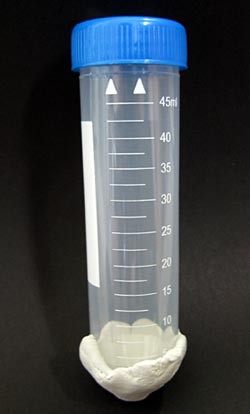 Image Credit: Teisha Rowland, Science Buddies / Science Buddies
Image Credit: Teisha Rowland, Science Buddies / Science Buddies
Figure 2. Mold the putty so that it fits in a thick layer around the very bottom of the 50 mL centrifuge tube.
- Repeat steps 1-4 with a second tube.
- Place the two tubes in the salad spinner basket as shown in Figure 3. Put each of the tubes on opposite sides of the basket and tilt them so that their tops meet in the center.
- Wedge and push the putty ends of the tubes into the bottom edge of the basket.
- Try to keep tubes in place by molding the putty to the basket a little.
- Do not worry if the tubes fall over. You will be securing them in place more firmly in the following steps.
- Wedge and push the putty ends of the tubes into the bottom edge of the basket.
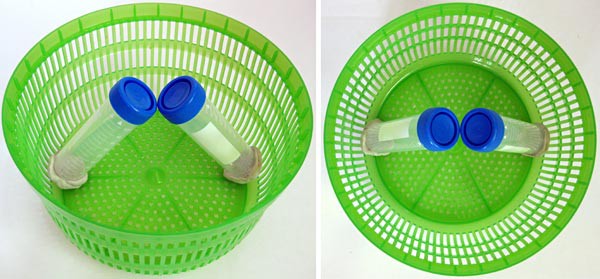 Image Credit: Teisha Rowland, Science Buddies / Science Buddies
Image Credit: Teisha Rowland, Science Buddies / Science Buddies
Figure 3. Tilt the two tubes so that their putty ends are wedged in the bottom edge of the basket and their tops meet in the center. The pictures show the tubes from two different angles in the basket.
- Using two new tubes, repeat steps 1-6 so that you have a total of four tubes with putty on one end. Place the two new tubes in the basket as shown in Figure 4. Put the new tubes between the ones already in the salad spinner basket and tilt the new tubes so that their tops also meet in the center.
- Again, wedge and push the putty ends of the tubes down into the edge of the basket.
- Try to keep the tubes in place by molding the putty to the basket a little.
- Each tube should be about the same distance from the tube on its left or right.
- Do not worry if the tubes fall over. Just try to keep them roughly in place.
- Again, wedge and push the putty ends of the tubes down into the edge of the basket.
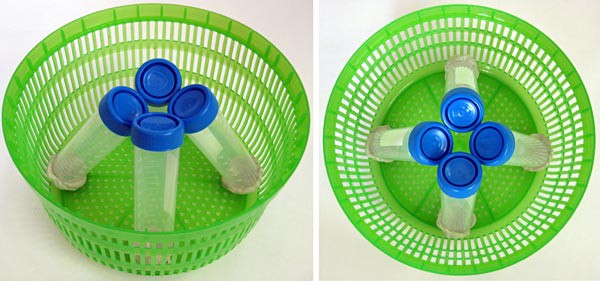 Image Credit: Teisha Rowland, Science Buddies / Science Buddies
Image Credit: Teisha Rowland, Science Buddies / Science Buddies
Figure 4. Place four tubes with putty on their ends in the salad spinner basket so that each tube has its putty end wedged into the bottom edge of the basket and the tops of the tubes meet in the center. Keep all tubes equally spaced from each other. The pictures show the tubes in the basket from two different angles.
- Place four small pieces of putty in between the tubes where they meet at the center of the basket, as shown in Figure 5.
- This will help keep the tubes in place when they are being spun.
- Try to adjust the tubes so that they are as centered as possible.
- Using thicker pieces of putty will work better.
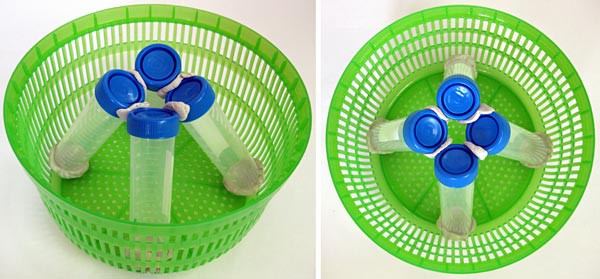 Image Credit: Teisha Rowland, Science Buddies / Science Buddies
Image Credit: Teisha Rowland, Science Buddies / Science Buddies
Figure 5. Place four small pieces of putty in between the tubes where they meet at the basket's center to help keep them in place. The pictures show the tubes in the basket from two different angles.
- Once the tubes are centered and seem stable, put a rubber band tightly around the tops of the tubes, as shown in Figure 6. Put three or four rubber bands on the tubes in this way.
- This will help keep the tubes in place when they are being spun.
- Make sure the rubber bands are tight around the tops of the tubes.
- If you have larger rubber bands, fold the band on itself and put both loops around the tops of the tubes.
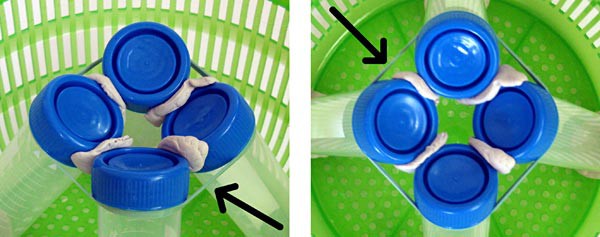 Image Credit: Teisha Rowland, Science Buddies / Science Buddies
Image Credit: Teisha Rowland, Science Buddies / Science Buddies
Figure 6. Put three or four rubber bands around the tops of the tubes, as shown here with one rubber band (marked by the arrow). This will help keep the tubes in place. The pictures show the tubes in the basket from two different angles.
- Place the basket in the salad spinner and put the lid on the spinner, making sure it fits over the tubes inside.
- If it does not quite fit, try slightly adjusting the positioning of the tubes to see if you can get the lid to fit.
- If you still cannot fit the lid on the salad spinner, you may need to use a larger salad spinner or a different style of salad spinner for this project. Note: See the Materials and Equipment list for details on the kind of salad spinner needed.
- Set a timer for one minute or have a clock nearby.
- Spin the salad spinner with the tubes inside the basket for one minute.
- Tip: Try holding the salad spinner flat on a counter with one hand while spinning the salad spinner with your other hand. You might want to ask an adult helper to hold the salad spinner in place.
- If the tubes do not stay in place, try any of the following:
- If it looks as if the tubes' tops are not centered and equally spaced from each other, try to adjust them.
- Add more putty between the tubes.
- Put another rubber band around the tubes' tops.
- If it is the putty ends that came loose, push the ends more into the edge of the basket, molding the putty into the basket.
- If the tubes stay in place, your salad spinner is ready to be used as a centrifuge.
Centrifuging Glitter
In this part of the science project, you will test your salad spinner centrifuge on glitter in liquid to see how well your centrifuge separates the glitter from the liquid. Specifically, you will compare how well your centrifuge separates the glitter from the liquid to how well gravity alone does this.
- Remove the tubes from the centrifuge, one by one.
- Take off the rubber bands and remove all of the putty from each tube.
- If the putty gets wet, it may not work well anymore, so try to keep it dry.
- To each of the four tubes, do the following:
- Add ¼ teaspoon (tsp.) of glitter.
- You should do this over a piece of paper so that it is easy to collect any glitter that does not make it into the tube!
- Add 10 mL of water.
- Use the markings on the tubes so you know how much 10 mL is. The mark near the bottom that says "10" is where you should stop pouring to get 10 mL.
- What does the glitter do when you add the water? Where does it end up in the tube?
- Add one drop of liquid dish detergent.
- The detergent should help prevent glitter from sticking to the tube or floating.
- Add 30 mL of light corn syrup.
- Again, use the markings on the tube so that you know when you have added enough light corn syrup.
- Because each tube already has 10 mL of liquid in it, adding 30 mL of liquid corn syrup should fill it with a total of 40 mL of liquid, so add the liquid corn syrup until each tube is filled up to the mark near the top that says "40."
- Why do you think you need to add corn syrup? In step 2b, you may have seen that the glitter quickly falls to the bottom of the tube when it is in water. Adding corn syrup makes the liquid more viscous, or thicker and less fluid, which causes the glitter to take longer to fall to the bottom of the tube. This is important because it will enable you to compare more easily how well the glitter separates from the liquid using the centrifuge compared to using gravity alone.
- Add ¼ teaspoon (tsp.) of glitter.
- Wipe all four tubes down with a paper towel or rag.
- If liquid gets on the adhesive putty it can damage it and make it unusable in the centrifuge.
- Using a permanent marker, label one tube #1, another tube #2, another #3, and the last #4.
- Put the cups of putty on the bottom of each tube again. Make sure the putty is firmly attached to each tube.
- Quickly flip each tube upside down and then right-side up again. (This is called inverting the tube.) Do this about 10 times for each tube or until the glitter is evenly mixed throughout each tube. Invert each tube the same number of times.
- If the glitter is not evenly mixed, invert the tubes a few more times until it is.
- Do this to all four tubes at the same time. You can try doing this by having two in each hand or by having an adult help you do this.
- Take a moment to look at how the glitter looks in the tubes, but do not take too long.
- Arrange the tubes in the centrifuge, as shown in Figure 6 in the previous section.
- Set the centrifuge up with these tubes as you did in the section titled "Make Your Centrifuge," following steps 6-10, using the putty pieces you already molded and prepared.
- Spin the tubes in the centrifuge for one minute.
- Do this as you did in the "Make Your Centrifuge" section in steps 11-12.
- Try to spin the centrifuge at a regular speed, as fast as you feel comfortable going, for most of the minute.
- When the minute is up, stop spinning the centrifuge and let the tubes slowly come to a stop (do not quickly stop the centrifuge from spinning; doing that might cause your samples to remix).
- Tip: If one of the tubes comes loose while you are spinning them, stop the timer and slowly stop the centrifuge. Try to figure out why the tube came loose and troubleshoot the problem by following step 12b in the previous section. After securing the tubes, continue the timer and resume spinning the tubes.
- If it looks like the sudden stop remixed some tubes but not others, repeat steps 6-8 (in this section) for all four tubes.
- Carefully remove each tube from the centrifuge. Have an adult helper try to hold each tube at about the same angle as it was in the centrifuge. Remove the putty from the tubes. Look at each tube.
- Where is the glitter in each tube? Is it all on the bottom, or is some on the sides or still floating around in the middle of the tubes? If there is glitter on the side of the tube, which side is it, in relation to how the tube was angled in the centrifuge? Write your observations in your lab notebook.
- If there is some glitter on the side of the tube, why do you think this would be? Hint: Re-read the Introduction.
- Where is the glitter in each tube? Is it all on the bottom, or is some on the sides or still floating around in the middle of the tubes? If there is glitter on the side of the tube, which side is it, in relation to how the tube was angled in the centrifuge? Write your observations in your lab notebook.
- At the bottom of each tube, there should be a small clump of glitter. This clump can be thought of as a pellet. But not all of the glitter will be at the bottom. There will also probably be a lot of glitter in the rest of the tube, especially on the side of the tube. Using a permanent marker or dry erase marker, make a small mark straight across where the pellet, or clump, seems to end, such as shown in Figure 7, on the left side, with the arrow.
- Tip: If you are having trouble seeing where the pellet ends, try holding the tube up to a bright light. The pellet is the area at the bottom of the tube where the light does not shine through. You may need to roughly estimate where the pellet ends.
- If you do not seem to have a pellet at the bottom of your tubes, try repeating steps 5-9 again but this time have an adult spin the tubes faster.
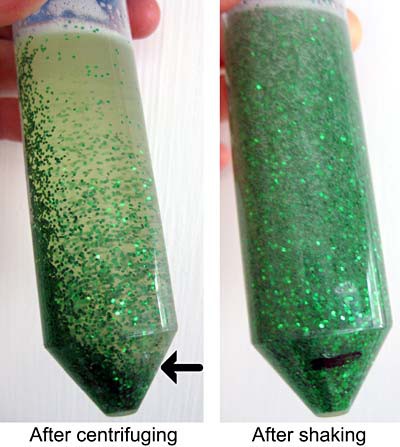 Image Credit: Teisha Rowland, Science Buddies / Science Buddies
Image Credit: Teisha Rowland, Science Buddies / Science Buddies
Figure 7. After spinning your tubes, use a permanent marker or dry erase marker to make a small mark where the pellet, or clump, ends in each tube. As an example, the arrow in the picture on the left shows where you would mark this tube. You may need to hold each tube up to a light to see where the pellet ends. In the picture on the left, you can see there is glitter along the left side of the tube. Why do you think this occurs? How do you think this tube was angled in the centrifuge? The picture on the right shows what this tube looks like after being marked and shaken again.
- Take a picture of each tube using a digital camera.
- For each tube, take a few pictures of the whole tube and of the pellet at the bottom.
- Try to include the number of the tube in the pictures. If you do not, in your lab notebook, try to keep track of which pictures go with which tubes.
- If you are using colored glitter, try to take the pictures in front of a solid white background.
- For each tube, take a few pictures of the whole tube and of the pellet at the bottom.
- Set up four tall, clear drinking glasses.
- Shake each tube as you did in step 6.
- The tubes should now look like the picture on the right in Figure 7.
- Set each tube upright in a drinking glass.
- Do not worry if the tube is leaning in the glass a little. Arrange the tubes so that you can see the marks you made at the bottom of each tube.
- Start a timer or write down what time it is in your lab notebook.
- Watch the tubes in the glasses to see how long it takes the glitter to form a pellet at the bottom of the tube that goes up to the mark you made.
- This may take several minutes, so you will need to be patient! After a few minutes, once you see how slowly the glitter is falling, you can check on the tubes every five minutes. Just do not forget about them!
- While you are waiting, copy Table 1 into your lab notebook. You will be writing your data in this data table.
- Note: Part of the data table has already been filled in for you. Because you should always be spinning the centrifuge for one minute, you will record that it takes one minute for the glitter to settle when it is centrifuged.
Time for Glitter to Settle Trial #1 Trial #2 Trial #3 Centrifuging Gravity Alone Centrifuging Gravity Alone Centrifuging Gravity Alone Tube #1 1 minute 1 minute 1 minute Tube #2 1 minute 1 minute 1 minute Tube #3 1 minute 1 minute 1 minute Tube #4 1 minute 1 minute 1 minute Average 1 minute 1 minute 1 minute
Table 1. In your lab notebook, make a data table like this one. You will be writing your data in it. Note: The centrifuging times have already been filled in for you. (Because, according to the Experimental Procedure, you should always spin the centrifuge for one minute, you will record that it takes one minute for the glitter to settle when centrifuged.)
- It may be hard to tell exactly when the glitter settles up to the pellet mark you made, so just do your best job at estimating when it reaches the mark.
- Tip: If you are having trouble seeing where the pellet ends, try holding the tube up to a bright light, but do not jostle or shake the tube. The pellet is the area at the bottom of the tube where the light does not shine through.
- You can compare how much glitter is settled in the tube to how much was settled in the picture you took right after centrifuging.
- When the glitter fills up to the pellet mark on a tube, check the timer or see what time it is. How long did it take the glitter to settle to the mark in that tube?
- Write this time in the data table in your lab notebook. Write it in the "Gravity Alone" column.
- Repeat this step for each tube.
- When the glitter has settled to the mark, make and record observations of each tube as you did in step 9 and take a picture of each tube as you did in step 11. How does the glitter in the tube look different from how it looked just after centrifuging?
- Clean off the mark you made at the bottom of each tube.
- If you are using a dry erase marker, use a paper towel or rag to wipe the mark off.
- If you are using a permanent marker, have an adult help you put a dab of 70% isopropyl rubbing alcohol on a paper towel or rag and wipe the mark off with it.
- Repeat steps 5-17 two more times. Each time, in step 16, record your times under a different trial number. You should do a total of three trials this way.
- Repeating an experiment three times is important to show that your results are accurate and reproducible.
- Once you have completed the three trials, look at the data table in your lab notebook and analyze your results. How efficient is the centrifuge?
- Calculate the average time it took for the glitter to settle by gravity alone for each trial by adding up the time it took for each tube and then dividing this number by four. Write these answers in your data table in the row labeled "Average."
- Make a bar graph of the average time it took the glitter to settle in each trial. You will want to make one graph for each trial, so you should end up with three graphs total. On the y-axis (the vertical axis going up and down) put how long it took the glitter to settle and on the x-axis (the horizontal axis going across) label one bar "Centrifuging" and one bar "Gravity Alone." Do not forget to label each graph with the trial number.
- You can make a graph by hand or use a website like Create A Graph to make a graph on the computer and print it.
- Was using your centrifuge more efficient at making the glitter settle to the bottom of the tubes than using gravity alone, which you tested when you placed the tubes in the glasses?
- Hint: When you spun the tubes in the centrifuge, you spun them for one minute. How many minutes did it take the glitter to make the same-sized pellet when the tubes were placed in the glasses? Did it take a lot longer?
- What other differences did you notice about where the glitter was in the tubes after centrifuging them or letting them settle to make a same-sized pellet? Why do you think this happens?
- You may want to include some of the pictures you took on your project display board! If you do, you may also want to take a picture of what the glitter in the tube looks like right after it has been shaken.
- Centrifuges used in laboratories spin even faster than the one you made for this project. If you spun your tubes in one of these centrifuges, what do you think the glitter would look like afterwards? Where would it be in the tube?
Ask an Expert
Global Connections
The United Nations Sustainable Development Goals (UNSDGs) are a blueprint to achieve a better and more sustainable future for all.
Variations
- In this science project, you mixed glitter with 10 mL of water and 30 mL of light corn syrup. This is a 1:3 ratio, because you used three times as much light corn syrup as you used water. What do you think would have happened to the glitter if you used more or less light corn syrup? Try this science project again but this time compare different ratios of water to light corn syrup. Be sure to fill the tubes to a total of 40 mL each time. How well does a clump of glitter form when you centrifuge glitter in a different ratio? Does it take a different amount of time for the glitter to settle due to gravity when a different ratio is used? Here are some ratios you can try:
- 3:1 (30 mL of water and 10 mL of light corn syrup)
- 1:1: (20 mL of water and 20 mL of light corn syrup)
- 1:3 (10 mL of water and 30 mL of light corn syrup, as you did in this science project)
- You could also try 40 mL of just water and 40 mL of just light corn syrup.
- What makes the best snow globe recipe? Based on your observations in this science project, think about how you could change the recipe so that the glitter in the tubes acts more like a snow globe. Some things you could try include different amounts of glitter, light corn syrup, water, and dish detergent. You could test even more variables, such as the temperature of the water and using glycerine instead of light corn syrup. Is there something you could test instead of glitter? You may want to prepare your "snow globes" in mason jars (with lids) instead of centrifuge tubes. Observe a real snow globe to see how long it takes the particles to settle and try and use a similar amount of glitter in yours. Be sure to take careful notes in your lab notebook on everything you try so that you know what did not work well, and what makes the best "snow globe"!
- You can use your centrifuge to investigate solubility, or how well a substance is dissolved by another substance. For example, liquids that dissolve in water (known as water-soluble liquids) do not usually mix well with liquids that dissolve in fats (known as fat-soluble liquids). Because of this, water-soluble and fat-soluble liquids can usually be separated easily. You can try to determine the solubility of a liquid by mixing it in equal parts with carrot juice or another water-soluble liquid (such as water) and olive oil, a fat-soluble liquid. Centrifuge the mixture and see which layer got bigger, the water layer or the oil layer. Did the liquid turn out to be water-soluble or fat-soluble? Some things you could test include rubbing alcohol, molasses, corn syrup, honey, maple syrup, petroleum jelly (e.g., Vaseline®), vinegar, different kinds of oils, and liquid dish detergent.
- If you spin a sample faster in the centrifuge, will it separate better? Use the tubes of glitter you prepared in this project and see what happens when you spin them slowly in the centrifuge for one minute. Compare how this looks to when you spin them faster in the centrifuge for one minute. You can count the number of turns you do in one minute so you know how slow or fast you are spinning the samples. How did spinning the tubes fast compare to spinning them slowly? Is this what you would expect?
- How can you make your salad spinner centrifuge work even better? Think of how to improve upon the design of your centrifuge, such as by using other kinds of tubes, other ways to attach the tubes, making it more durable, or even using a different kind of system to spin the tubes (such as a different salad spinner style or even a bicycle wheel). Determine how you can measure your centrifuge's efficiency, perhaps by looking at how quickly the glitter settles into a pellet or determining how many times the tubes make a full rotation in the centrifuge in one minute (or rotations per minute [rpm]). Can you make your centrifuge more efficient?
Is it close to being as efficient as a laboratory centrifuge?
- As an example of another kind of salad spinner centrifuge, here is one design used to spin small tubes: Baichtal, J. (2010, March 16). Make a lab centrifuge out of a salad spinner. Make. Retrieved August 21, 2012, from http://blog.makezine.com/2010/03/16/make-a-lab-centrifuge-out-of-a-sala/
- For more science project ideas on density and centripetal force, see:
Careers
If you like this project, you might enjoy exploring these related careers:
Related Links
- Science Fair Project Guide
- Other Ideas Like This
- Biotechnology Project Ideas
- My Favorites
- Separating Butter with a Salad Spinner Centrifuge





